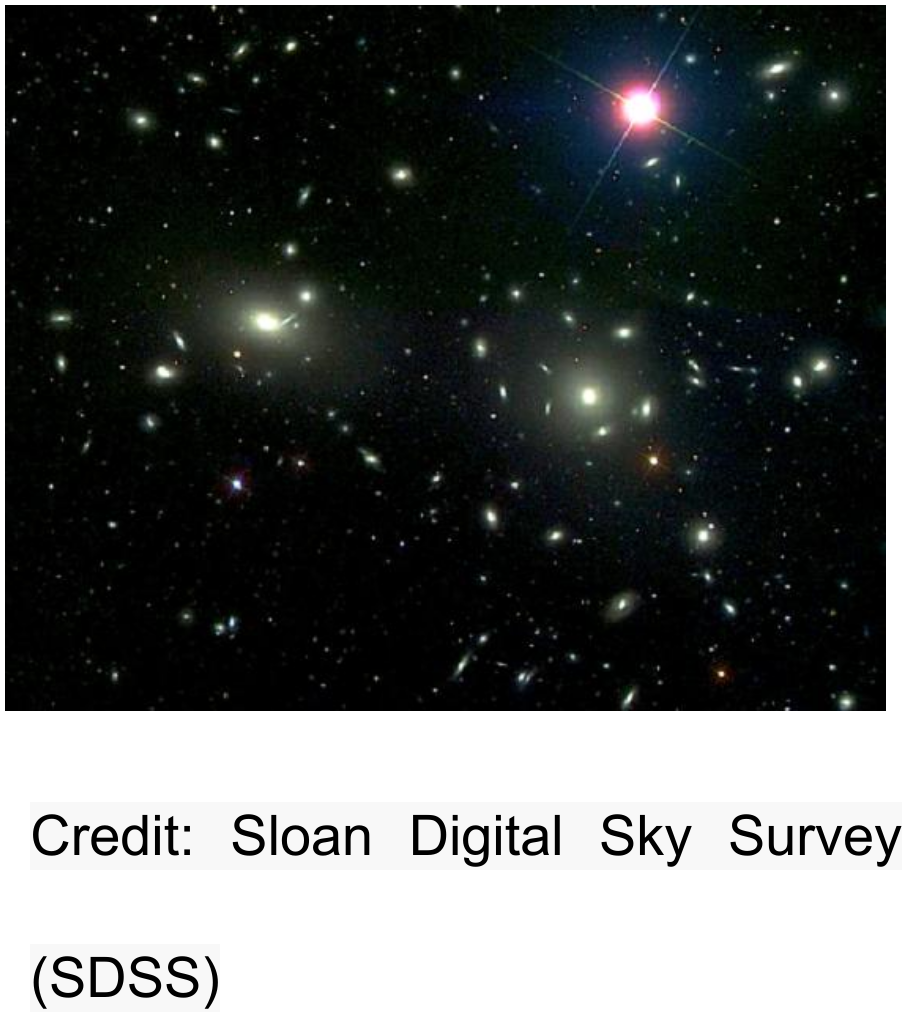[Filaments and Fireballs フィラメントと火の玉]

The Coma Cluster of galaxies.
かみのけ座銀河団(コマクラスター銀河)。
――――――――
Apr 21, 2009
スバル望遠鏡からのかみのけ座銀河団(コマ・クラスター)の最近の画像は、イオン化ガスの明るい「結び目」をつなぐ銀河フィラメントを明らかにしています。
レッドシフトの計算によると、かみのけ座銀河団は、地球から3億光年以上離れた、直径350万光年の銀河の球体です。
このクラスターは、観測可能な宇宙で最もコンパクトな質量の蓄積の1つであり、1億ケルビンの温度で測定されたガスと塵の霞の中に1000個以上の銀河が集まっています。
天文学者達は、コマの中央領域から噴出する強力なX線放射について熟考し続けていますが、これまでのところ、理論的な説明は得られていません。
スバル望遠鏡のデータを分析している科学者たちは最近、クラスターに生息するより大きな楕円銀河の1つであるRB199から出現する「糸のような構造」の発見を発表しました。
〈https://subarutelescope.org/old/Pressrelease/2008/10/06/index.html〉
フィラメントはRB199から約260,000光年伸びており、光るイオン化された殻に囲まれた密接に関連した恒星達のグループを含んでいます。
研究者たちは、これらの急速に動く星団の結び目を「火の玉」と呼んでいます、銀河から発射される炎の発射体のように見えるからです。
〈https://www.subarutelescope.org/old/Pressrelease/2008/10/06/fig03E.jpg〉
恒星達のコンパクトな塊が形成された原因は何ですか?
1つの提案は、別の銀河が近くを通り過ぎたとき、重力の「潮汐力」がRB199から恒星達とガスを引き出しました。
別の提案は、かみのけ座銀河団(コマ・クラスター)の中心に向かう銀河の動きに基づいていました。
それがクラスターの中央の塊に加速するにつれて、ブローバック力が構成を押し出し、宇宙の彗星の尾のように進行方向から遠ざける可能性があります。
[*ブローバック:吹き戻し]
しかしながら、どちらの推測も、温度が数千万ケルビンを超えることがわかった恒星達と結ばれたガスの特性に対応することができませんでした。
すばるチームは、RB199が銀河団の「中心に衝突」するため、「ラム圧力」の影響を受けていると最終的に結論付けました。
[*ラム圧:抵抗の力を利用した圧力のこと。]
長いフィラメントを形成したのは、実際には、毎秒ほぼ2000キロメートルで移動する銀河と相互作用するかみのけ座銀河団の高温ガスからの摩擦です。
ガスと塵が互いにこすり合うと、RB199から物質が剥ぎ取られ、過熱した恒星の火の玉ができました。
スバルチームの主任研究員である吉田道敏博士は次のように述べています:
「チームは、これらの現象の研究が、銀河団のガス・ストリッピング・プロセスと、個々の銀河の進化に対する銀河団の影響についてのより良い理解につながると確信しています。」
皮肉なことに、吹流し、衝撃波、衝突は、宇宙で高周波電磁放射を発生させる現象を説明するためによく使用されます。
高度な天文学が始まって以来、従来の理論家達は、宇宙でのガンマ線、X線、および極紫外線の生成を重力と加速に依存してきました。
水素ガスの圧縮は、いくつかの恒星達のコアよりも高い温度に達するのに十分な運動量の伝達を生み出すと考えられています。
言い換えれば、ガスを非常に明るく輝かせるのはガスの高温です。
以前の「今日の写真」の記事で、私達は、宇宙の多くの構造物がアクティブなエネルギー源であることに気づきました
―一部の銀河達は、帯電(荷電)した物質を極から放出したり、数千光年にわたって長い編組の尾を残したりします。
小さな地層(恒星や惑星状星雲)は、しっかりと束ねられたフィラメントで構成された砂時計の形をしています。
このようなフィラメント状の構造は、バークランド電流として知られています。
プラズマ宇宙論者達は、活発な「ラジオ波(=電波)」銀河からそれらの極のはるか上にある「ラジオ波(=電波)銀河」まで伸びるフィラメントがバークランド電流の特徴であることを長い間知っていました。
宇宙のほとんどすべての天体達は、ある種の線維化を示します。
たとえば、金星には、NASAの科学者達が「ストリンジィ・シングス(糸を引くもの)」と呼ぶもので構成された尾があります。
彗星の尾は、「糸状の」イオン尾で構成されています。
惑星状星雲からの輝きは、複雑なウェブに解像されます。
ハービッグ‐ハロー恒星とエネルギッシュな銀河の噴流は、多くの場合、編組フィラメントに分解され、一部の銀河の渦巻腕は、それらから伸びる物質の糸で「髪の」ように見えます。
これらのフィラメントはすべてバークランド電流ですが、回路全体の目に見える部分のみを表しています。
回路の残りの部分は、マッピングできる磁場を生成する可能性があるため、マップは回路の範囲を示します。
銀河系回路のすべての要素(又は元素)はエネルギーを放射し、より大きな回路との結合によって電力を供給される必要があります。
それらのより大きな回路の範囲は、銀河がストリングで発生するという観察によって示されます。
〈https://takaakifukatsu.hatenablog.jp/entry/2021/06/08/214127〉
結論として、RB199から外側に爆発するフィラメント状の結び目は、宇宙電流の電磁ピンチゾーンでプラズマの輝く「火の玉」を形成する宇宙の電気の別の例であるように思われます。
By Stephen Smith
スティーブン・スミス
――――――――
Apr 21, 2009
Recent images of the Coma Cluster from the Subaru Telescope reveal galactic filaments connecting bright "knots" of ionized gas.
スバル望遠鏡からのかみのけ座銀河団(コマ・クラスター)の最近の画像は、イオン化ガスの明るい「結び目」をつなぐ銀河フィラメントを明らかにしています。
According to redshift calculations, the Coma Cluster is a sphere of galaxies 3.5 million light years in diameter over 300 million light years from Earth.
レッドシフトの計算によると、かみのけ座銀河団は、地球から3億光年以上離れた、直径350万光年の銀河の球体です。
The cluster is one of the most compact mass accumulations in the observable universe with more than 1000 galaxies grouped together inside a haze of gas and dust that has been measured at a temperature of 100 million Kelvin.
このクラスターは、観測可能な宇宙で最もコンパクトな質量の蓄積の1つであり、1億ケルビンの温度で測定されたガスと塵の霞の中に1000個以上の銀河が集まっています。
Astronomers continue to ponder the intense x-ray emissions blaring out from Coma's central region, a finding that has, thus far, eluded theoretical explanation.
天文学者達は、コマの中央領域から噴出する強力なX線放射について熟考し続けていますが、これまでのところ、理論的な説明は得られていません。
Scientists analyzing data from the Subaru Telescope recently announced the discovery of a "thread-like structure" emerging from RB199, one of the larger elliptical galaxies inhabiting the cluster.
スバル望遠鏡のデータを分析している科学者たちは最近、クラスターに生息するより大きな楕円銀河の1つであるRB199から出現する「糸のような構造」の発見を発表しました。
〈https://subarutelescope.org/old/Pressrelease/2008/10/06/index.html〉
The filament extends approximately 260,000 light years from RB199 and contains groups of stars in close association that are enclosed by glowing, ionized shells.
フィラメントはRB199から約260,000光年伸びており、光るイオン化された殻に囲まれた密接に関連した恒星達のグループを含んでいます。
Researchers refer to these rapidly moving star cluster knots as "fireballs," because they look like flaming projectiles shooting out from the galaxy.
研究者たちは、これらの急速に動く星団の結び目を「火の玉」と呼んでいます、銀河から発射される炎の発射体のように見えるからです。
〈https://www.subarutelescope.org/old/Pressrelease/2008/10/06/fig03E.jpg〉
What caused the compact clumps of stars to form?
恒星達のコンパクトな塊が形成された原因は何ですか?
One proposal was that gravitational "tidal forces" pulled stars and gas out from RB199 as another galaxy passed close by.
1つの提案は、別の銀河が近くを通り過ぎたとき、重力の「潮汐力」がRB199から恒星達とガスを引き出しました。
Another suggestion was based on the movement of the galaxy toward the center of the Coma Cluster.
別の提案は、かみのけ座銀河団(コマ・クラスター)の中心に向かう銀河の動きに基づいていました。
As it accelerated into the central mass of the cluster, the blow-back force could have pushed the formations out and away from the direction of travel like a cosmic comet tail.
それがクラスターの中央の塊に加速するにつれて、ブローバック力が構成を押し出し、宇宙の彗星の尾のように進行方向から遠ざける可能性があります。
[*ブローバック:吹き戻し]
However, neither conjecture was able to accommodate the characteristics of the stars and the knotted gas whose temperature was found to exceed tens of million Kelvin.
しかしながら、どちらの推測も、温度が数千万ケルビンを超えることがわかった恒星達と結ばれたガスの特性に対応することができませんでした。
The Subaru team finally concluded that RB199 is being affected by "ram pressure" as it "crashes into the center" of the galaxy cluster.
すばるチームは、RB199が銀河団の「中心に衝突」するため、「ラム圧力」の影響を受けていると最終的に結論付けました。
[*ラム圧:抵抗の力を利用した圧力のこと。]
It is actually friction from the Coma Cluster's hot gases interacting with the galaxy moving at almost 2000 kilometers per second that formed the long filaments.
長いフィラメントを形成したのは、実際には、毎秒ほぼ2000キロメートルで移動する銀河と相互作用するかみのけ座銀河団の高温ガスからの摩擦です。
Gas and dust scraping against each other stripped material off RB199 and created the superheated stellar fireballs.
ガスと塵が互いにこすり合うと、RB199から物質が剥ぎ取られ、過熱した恒星の火の玉ができました。
Dr. Michitoshi Yoshida, the Subaru team's lead investigator said:
“The team is confident that our study of these phenomena leads to a better understanding of the gas stripping processes in galaxy clusters, and the effect of clusters on the evolution of individual galaxies."
スバルチームの主任研究員である吉田道敏博士は次のように述べています:
「チームは、これらの現象の研究が、銀河団のガス・ストリッピング・プロセスと、個々の銀河の進化に対する銀河団の影響についてのより良い理解につながると確信しています。」
Irony aside, wind socks, shock waves and collisions are often used to describe phenomena that create high-frequency electromagnetic radiation in the cosmos.
皮肉なことに、吹流し、衝撃波、衝突は、宇宙で高周波電磁放射を発生させる現象を説明するためによく使用されます。
Since the beginning of advanced astronomy, conventional theorists have relied on gravity and acceleration for the production of gamma rays, x-rays and extreme ultraviolet light in space.
高度な天文学が始まって以来、従来の理論家達は、宇宙でのガンマ線、X線、および極紫外線の生成を重力と加速に依存してきました。
Hydrogen gas compression is supposed to create enough transfer of momentum that it reaches temperatures greater than the cores of some stars.
水素ガスの圧縮は、いくつかの恒星達のコアよりも高い温度に達するのに十分な運動量の伝達を生み出すと考えられています。
In other words, it is the high temperature of the gas that makes it glow so brightly.
言い換えれば、ガスを非常に明るく輝かせるのはガスの高温です。
In previous Picture of the Day articles, we noted that many structures in the universe are active energy sources
—some galaxies eject charged matter out from their poles, or leave long braided tails extending for thousands of light-years.
以前の「今日の写真」の記事で、私達は、宇宙の多くの構造物がアクティブなエネルギー源であることに気づきました
―一部の銀河達は、帯電(荷電)した物質を極から放出したり、数千光年にわたって長い編組の尾を残したりします。
Smaller formations (stars and planetary nebulae) have hourglass shapes composed of tightly bunched filaments.
小さな地層(恒星や惑星状星雲)は、しっかりと束ねられたフィラメントで構成された砂時計の形をしています。
Such filamentary structures are known as Birkeland currents.
このようなフィラメント状の構造は、バークランド電流として知られています。
Plasma cosmologists have long known that the filaments extending from active "radio" galaxies to the "radio lobes" far above their poles are the signature of Birkeland currents.
プラズマ宇宙論者達は、活発な「ラジオ波(=電波)」銀河からそれらの極のはるか上にある「ラジオ波(=電波)銀河」まで伸びるフィラメントがバークランド電流の特徴であることを長い間知っていました。
Almost every body in the universe displays some kind of filamentation.
宇宙のほとんどすべての天体達は、ある種の線維化を示します。
Venus, for example, has a tail composed of what NASA scientists call "stringy things."
たとえば、金星には、NASAの科学者達が「ストリンジィ・シングス(糸を引くもの)」と呼ぶもので構成された尾があります。
Comet tails are composed of "stringy" ion tails.
彗星の尾は、「糸状の」イオン尾で構成されています。
The glow from planetary nebulae resolve into intricate webs.
惑星状星雲からの輝きは、複雑なウェブに解像されます。
The jets of Herbig-Haro stars and energetic galaxies are often resolved into braided filaments, and the spiral arms of some galaxies look "hairy" with threads of material extending from them.
ハービッグ‐ハロー恒星とエネルギッシュな銀河の噴流は、多くの場合、編組フィラメントに分解され、一部の銀河の渦巻腕は、それらから伸びる物質の糸で「髪の」ように見えます。
All those filaments are Birkeland currents, but they only represent the visible portion of an entire circuit.
これらのフィラメントはすべてバークランド電流ですが、回路全体の目に見える部分のみを表しています。
The rest of the circuit may generate magnetic fields that can be mapped, so the map will indicate the extent of the circuit.
回路の残りの部分は、マッピングできる磁場を生成する可能性があるため、マップは回路の範囲を示します。
Every element in a galactic circuit radiates energy, and it must be powered by its coupling with larger circuits.
銀河系回路のすべての要素(又は元素)はエネルギーを放射し、より大きな回路との結合によって電力を供給される必要があります。
The extent of those larger circuits is indicated by the observation that galaxies occur in strings.
それらのより大きな回路の範囲は、銀河がストリングで発生するという観察によって示されます。
〈https://takaakifukatsu.hatenablog.jp/entry/2021/06/08/214127〉
In conclusion, it seems apparent that the filamentary knots exploding outward from RB199 are another example of electricity in space forming glowing "fireballs" of plasma in the electromagnetic pinch zones of cosmic currents.
結論として、RB199から外側に爆発するフィラメント状の結び目は、宇宙電流の電磁ピンチゾーンでプラズマの輝く「火の玉」を形成する宇宙の電気の別の例であるように思われます。
By Stephen Smith
スティーブン・スミス